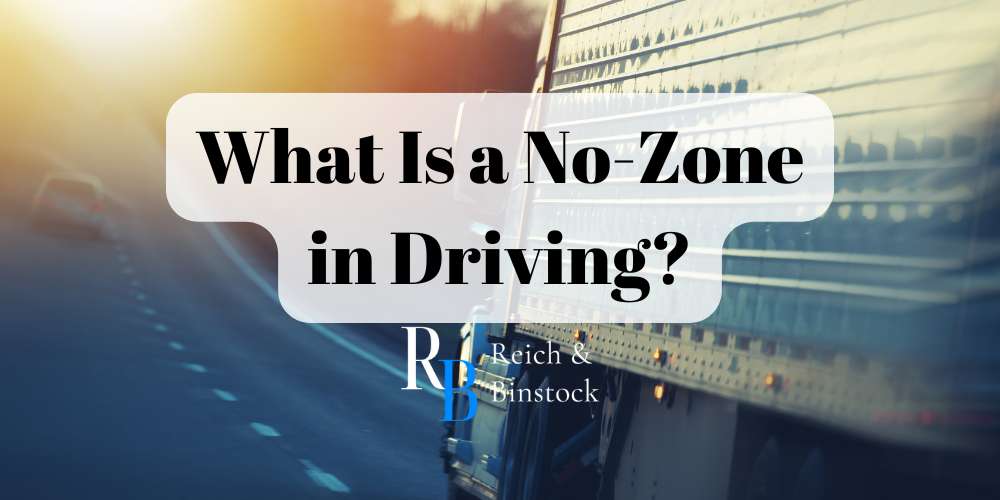Understanding Semi-Truck Blind Spots
All semi-trucks have several large blind spots, which significantly affects a trucker’s ability to see other vehicles on the roads. These blind spots are also called danger zones or no zones. Unfortunately, vehicles that drive in a truck’s blind spot can suffer serious injuries. But what is a no zone, and how can being aware help you avoid an accident?
Personal injury attorneys at Reich & Binstock have extensive experience representing victims of major accidents involving semi-truck blind spots. Call us today at 713-622-7271 for a free consultation about your case.
What Are No Zones of a Truck?
No zones are basically semi-truck blind spots. Just like the average passenger vehicle has blind spots, so do big rigs. However, a truck’s no zones are much more dangerous for other drivers on the roads because truck drivers generally can’t see you even with their mirrors.
Drivers in passenger vehicles may see you if they turn over their shoulders or look closely in their mirrors before changing lanes. If you’re in a no-zone, the truck driver can’t see you at all (even if they look in their mirrors), and you could get into a serious accident if you’re not careful.
No Zone Program of 1994

In an effort to keep everyone safe and aware on the roads, the FMCSA started the No Zone Program (also known as the Share the Road Program) in 1994. The goal of the program is to inform drivers of semi-truck blind spots and to teach passenger vehicles how to share the roads safely. The program is still ongoing because a truck driver’s blind spot has continued to prove deadly, resulting in fatal injuries for other drivers.
What Are the Four Truck Blind Spots?
It’s important for every passenger vehicle to know that all semi-trucks have four no zones: the right, left, rear, and front.
Right Side No Zone
The right side is possibly a truck driver’s biggest blind spot. It starts approximately two lanes to the right at a diagonal slant from the truck’s cab. Basically, if you can’t see the truck driver’s face in their right side mirrors, then you’re probably invisible to them. That’s why you should always try to pass a truck on its left side because while that side still has a blind spot, they are more likely to see you compared to the right side.
Left Side No Zone
The left no zone of a semi-truck has a smaller blind spot than the right side. It starts approximately one lane over near the cab. The general rule still applies: if you can’t see a truck driver’s reflection in his or her side mirror, you’re probably invisible to them. It’s much safer to pass semi-trucks on this side, but it’s still not safe to ride in a truck’s no zone for long periods of time.
Rear No Zone
The rear blind spot is located immediately behind the truck’s trailer extending 30 feet or so. Tailgating any vehicle poses a dangerous situation because the driver could stop suddenly, causing a rear-end accident. This scenario is even more dangerous when people drive behind a truck driver because they are basically sitting in another large blind spot.
If you’re tailgating a truck, remember the truck driver cannot see you because they don’t have the luxury of a rearview mirror like most cars. Truckers rely solely on side-view mirrors and the caution of other smaller vehicles. The rear no zone begins within 30 feet behind a semi truck’s trailer.
Front No Zone
The front no zones of trucks are the last of a truck’s four blind spots. It begins within 20 feet in front of a truck. This means you should never cut off large trucks, especially at high speeds on the interstate. Truck drivers can’t immediately slow down as quickly as passenger cars, so you could suffer a major car accident if you cut them off.
In fact, it can take truck drivers twice as long to slow down compared to smaller cars. It’s important to allow at least one car length for every ten miles per hour you drive. For example, 60 mph would equal 6 car lengths. If you need a Houston car accident lawyer, we’re here for you.
How Can You Tell if the Driver of a Large Truck Can See You?

To determine if the driver of a large truck can see you, try to make eye contact with them. If possible, position yourself where you can see the driver’s face in one of the truck’s mirrors. Also, be mindful of blind spots around the truck, particularly along the sides and directly behind it.
If you’re unable to establish eye contact or see the driver’s reflection, assume they might not be aware of your presence and adjust your position accordingly to stay safe.
Safe Driving Tips for Passenger Vehicles
Before hitting the road, it’s important to remember these safe driving tips when passing trucks.
How To Avoid Blind Spots
Basically, if truck drivers cannot see you, you’re in danger. So don’t sit in a truck’s blind spots. Either pass the truck on its passenger side (if possible) or slow down so that the driver can see you. You will know if a truck driver can see you if you can see their face in one of their two mirrors.
Appropriate Following Distance
It’s best for any driver to give a large truck as much space as possible on the roads. Give the truck approximately 20 to 25 car lengths, allowing you to see both of their mirrors. It’s also important to allow this much space because:
- Debris could fall off a truck and hit you, like wood or equipment. The further away you are, the better.
- The truck could suddenly stop. If you’re following too closely, you won’t have enough time to slow down.
Lane Change in Front of a Truck
If a car is passing a truck and then wants to get back into the same lane, it must do so safely. Because, as previously mentioned, the front of the truck is also a no-zone. Before you move in front of a truck, make sure you can see its headlights in your rearview mirror. This will give the truck driver enough room to maneuver quickly if necessary.
To put things into perspective, a tractor-trailer that’s fully loaded can weigh up to 80,000 pounds. With this kind of weight, it can take drivers almost an entire football field to stop if necessary.
Safe Driving Tips for Semi Trucks

Sharing the road is about everyone practicing safe driving, including large commercial trucks. Keeping these tips in mind can save your life and others’ lives by preventing big rig accidents. Contact one of our Houston big rig accident attorneys for more information.
Always Be Vigilant
Because you’re driving one of the biggest vehicles on the road, you always have to be on the lookout for distracted drivers, road debris, poor weather conditions, crashes, and more. Make sure to scan about 15 seconds ahead on the roads.
This is about a quarter-mile on the interstate and one to two blocks in cities and towns. Additionally, it’s important to check your side mirrors every 8 to 10 seconds for cars passing you.
Always Use Signals
Always notify other drivers of what you’re doing. Use your turn signals for lane changes and your flashers for driving off the side of the road.
Know When to Slow Down
Because your vehicle is much bigger and heavier than most other cars, it takes longer for you to stop in case of emergencies. So always keep a safe distance between other cars and give yourself plenty of time to slow down.
Avoid Distracted and Sleepy Driving

Never text and drive, eat and drive, mess with a GPS and drive, etc. Distracted driving is dangerous for everyone, but it’s even more dangerous for drivers of large vehicles. In fact, truckers who text and drive are 23 times more likely to get into a truck accident, according to the FMCSA.
Additionally, don’t drive if you’re sleepy. You need rest, especially if you’ve been driving all day. Make sure to pull off at a rest stop and sleep instead of dozing off at the wheel. You could save your life or someone else’s life by resting when you need to. If you need a Houston truck accident attorney, contact Reich & Binstock today.
Call the Houston Truck Accident Lawyers at Reich & Binstock Today
If you or someone you love is suffering from an 18-wheeler accident, you need Houston personal injury attorneys from Reich & Binstock on your side. We’ve successfully defended our clients for years, ensuring that they receive the compensation and legal support they deserve. Call us today at 713-622-7271 for a free consultation.














